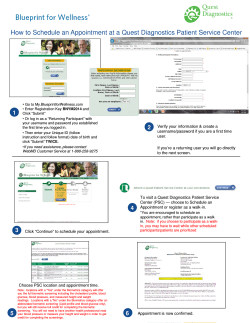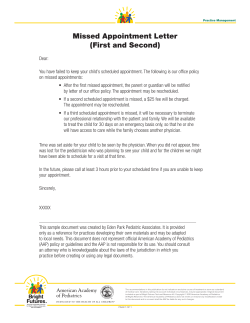
Document 188089
WASHINGTON BUREAU ∙ NATIONAL ASSOCIATION FOR THE ADVANCEMENT OF COLORED PEOPLE
TH
1156 15 STREET, NW SUITE 915 ∙ WASHINGTON, DC 20005 ∙ P (202) 463-2940 ∙ F (202) 463-2953
E-MAIL: WASHINGTONBUREAU@NAACPNET.ORG ∙ WEB ADDRESS WWW.NAACP.ORG
ADVOCATING YOUR CONCERNS
TO CONGRESS
There are many ways in which you, as a member of the electorate,
can contact your federally elected representatives to let them know of
your concerns, priorities, needs and desires. Regardless of which
method you choose to contact them, always remember to be polite,
make a cogent and assertive (yet respectful) argument, and always
ask for a reply or response. It also helps to always transmit
something in writing, so that they have a record of your interests and
ask for a written response in return so you have an indisputable
record of their positions and promises.
PERSONAL VISIT
For most members of the House and Senate, the best way to
communicate with them is a personal visit. A face-to-face meeting
may be the most effective way to communicate your concerns to
legislators. You can visit alone, but because it's more enjoyable and
effective to visit with others, the description below assumes that
you're visiting with one or more other people.
How Frequently Should You Visit?
Once or twice a year is probably as much as a
Member of Congress will see you. State legislators
are more accessible. If you represent an active group of voters, all
legislators are more likely to see you than if you go alone. It is more
effective to help other people to visit than to try to go frequently
yourself.
How Many People Should Go On a Visit?
You can go alone, although two to five people will fit comfortably in
most D.C. and local offices. Fewer people allow more discussion;
large groups tend to allow the legislator to dominate and give
speeches.
How To Visit
Five steps to remember when planning your visit are: make the
appointment, prepare, visit, de-brief, follow-up.
STEP 1: MAKE THE APPOINTMENT
Call the legislator’s office and make an appointment: Get
the local office number from the telephone book (look under the
legislator's name). Get a Member of Congress' D.C. number by
calling the Capitol Switchboard in D.C. (202/224-3121).
Ask to speak to the appointment secretary. Ask for a meeting.
State the issue you want to discuss, how many people will be coming,
whether you represent a group, preferred dates for visiting, and how
long you want to speak with the Member. Most Members of
Congress will also ask that a letter be faxed or mailed to their office
with the same information, so you may want to have that letter
prepared in advance.
THE EARLIER YOU CALL, THE MORE LIKELY YOU ARE TO
GET A DATE YOU WANT. It often takes weeks to get an
appointment with a Member of Congress.
Most visits run between 10 and 30 minutes, but don't hesitate to
ask for more, especially if you're visiting the legislator during a work
day in their office. Write down the appointment secretary's name for
future use.
You may be told that the legislator cannot meet with you, or
cannot see you for months. Just repeat your request. Say, "That
seems like a very long time. Could you please arrange an earlier
date?" They may say they'll call you back. Call back in a week if you
haven't heard from them. If after several calls you still didn't have an
appointment, find several community leaders, such as clergy,
business or labor leaders, or professionals, to join you. Invite other
groups (another congregation's social concerns committee or a
community organization) to join you. Have them call or write using
letterhead to request a meeting.
If this doesn't work, ask to speak to the Administrative Assistant
(the Legislator's right-hand staff person). Be polite, no matter how
abrupt or rude staff are. In fact, their rudeness increases your
leverage: they've done you wrong, and owe it to you to give you
some time. As a last resort, write a letter to the editor of your local
newspaper to draw attention to the legislator's inaccessibility for
average voters. (Be cautious; this could antagonize the legislator.
Just state the facts and express your dismay that the legislator will
not make time to see constituents who advocate for the pubic good.)
You can visit legislators either in Washington, D.C. or in a local
office. The legislator may be more available back home, and more
people can participate. However, there's nothing like a visit to the
capital to de-mystify the legislature and help people overcome their
fear of advocacy. Furthermore, staff who work on the issues are at
the legislature, and building a relationship with them may be a key to
success.
If a trip to Washington is not in your future, you can
try to meet with your Congressperson at home: many
members go home for most weekends, and there are
traditional “district work periods” around most holidays
(i.e., Memorial Day, Labor Day and the Fourth of July) in the early
spring and for the month of August. Many members can also be
found in their home districts after Congress adjourns for the year,
usually in October or November. Many members also hold “town
meetings” in their districts throughout the year; you can call their
district offices to ask if one is planned for your area, and if so when it
will be.
STEP 2: PREPARE
1. ESTABLISH A PROFILE OF THE MEMBER YOU ARE GOING
TO MEET. Review the legislator’s voting record, look up the
committees and subcommittees the legislator serves on. If you have
access to the Internet, look up his or her web site (www.house.gov or
www.senate.gov) and review the past press releases. The press
releases will give you a sense of what he or she has been doing to
date; the committee and subcommittee assignments should give you
insight into the issues the legislator tends to be more involved in.
Can you relate your concerns to the committee assignments?
2. DECIDE WHAT YOUR MESSAGE WILL BE.
Choose no more than two issues. Make a list of “key points” and
include ways that constituents are affected.
3. DECIDE WHO WILL SAY WHAT.
Who will start the meeting to say why you've come?
Who will state each key point?
Who will ask which questions?
Who will ask the legislator to take specific action?
Who will thank the legislator at the end of the visit?
People don't have to talk in order to go on the visit, but it's better to
share the communicating -- it shows the Member that everyone thinks
for themselves. Be prepared to explain (in one sentence) any bills
you refer to; the Member may not be familiar with the bill or when it is
scheduled for a vote.
Do a dry run, with each person briefly stating their part of the
message. You'll discover where there is confusion and overlap of
points.
Visits may be cut short. Be prepared to state your message and
make your request in a few minutes.
4. PREPARE RESPONSES.
How do you expect the legislator to respond?
Prepare answers.
5. TAKE A FACT SHEET, NEWSPAPER ARTICLE OR ANY
SUPPORTING INFORMATION THAT SUPPORTS YOUR VIEW.
Give it to the legislator at the end of the meeting.
6. DECIDE WHAT SPECIFIC ACTION YOU WANT.
STEP 3: VISIT
1.
TAKE THE INITIATIVE. Say why you're there. Everyone
introduce themselves. Mention your profession, background, and any
experience on the issue. Mention organizations that you belong to.
2.
THANK THE LEGISLATOR FOR SOMETHING -- a vote, a
speech, an electoral promise or their willingness to hear constituents'
views.
3.
MENTION A PAST VOTE ON YOUR ISSUE. This shows that
you follow how they vote and know that votes count, not promises! If
no vote has been taken, try to determine if the legislator has ever
taken a position on your issue (such as co-sponsoring legislation,
etc.)
4.
STATE YOUR MESSAGE BRIEFLY AND SUCCINCTLY.
State your view, your reasons for having that view ("key points"), and
other constituents who share your view (including organizations).
[Lobbyists use a single page of "talking points" to help them state key
points briefly.]
5.
ASK FOR A SPECIFIC ACTION. Be sure to ask how they plan
to vote. If they say that the bill is being rewritten or amended, ask for
the legislator's position on the bill as originally written. KEEP
ASKING UNTIL YOU GET SOME ANSWER. If they don't have a
position, ask how they plan to decide.
6. If time, ASK FOR INFORMATION. (See "Sample Questions").
Sample Questions
When you visit a legislator, try to learn about their attitudes and who
is lobbying them.
1.
Are you hearing from people who disagree with our position?
Who? What are their arguments? How much pressure are they
putting on you?
2.
What do you consider when deciding how to vote on this issue.
What sources of information do you rely on?
3.
We have found the following sources of information useful. Do
you see them as credible? If not, why?
4.
What would lead you to change your mind on this issue?
5.
Would you take leadership on this issue if you had more
support from constituents?
VISITORS TO D.C.: ASK TO MEET STAFF WHO WORK ON
ISSUES YOU FOLLOW. Use time waiting for the Member to get
to know issue staff. If the Member is unable to meet with you,
carry on the meeting with the staff person. They are worth your
time! They help the Member decide how to vote.
STEP 4: DE-BRIEF
Learn from the visit and decide what to do next. If you visited as a
group, go to a place where you can sit together and talk. (Do it now
while everything is fresh).
1.
Quick Impressions: Each person takes a turn filling in the
sentence, "I feel
about the meeting because _________."
If some people dominate, say, "You're saying important things, but
let's hear from everyone quickly."
2.
What went well? Make a list together. No negative comments!
3.
How did the Legislator or staff person respond to the group?
Non-committal, bored, interested, hostile, encouraging, defensive,
uncomfortable. . .? How can you tell? (Body language? Words?
Tone of voice? Short meeting?)
4.
What did you learn about the legislator? Any insights into their
"world view," motivation to be in politics, feelings about your issues,
feelings about you as constituents, reliance on staff for information, or
methods for handling meetings with constituents? [If you met with
staff, did she/he give you insights about the legislator? Did staff tell
you about the legislator's views or voting behavior?]
5.
What should the next step be? (Letters? Media? Another visit?)
6.
Who will send a follow-up letter to the legislator or staff to thank
them for the meeting and restate key points?
STEP 5: FOLLOW-UP
1.
Write a letter to the legislator or staff person, thanking them for
the meeting, briefly restating key points and reminding them of
commitments they made.
2.
If you promised to do something, do it. It's important to your
credibility.
3.
Report on the visit to your organization, congregation, or other
interested group. Ask people to write a letter (mentioning that you
briefed them). Bring paper, envelopes, stamps, and pens.
4.
Call local media groups to report what happened in your visit.
If a meeting with a legislator is not in your future, there are other ways
to contact your elected representatives:
WRITE A LETTER
Because office visits are sometimes difficult to schedule, especially in
a timely manner, letter writing is usually the next best option. There
are several ways of communicating through the mail
with your elected representative; a hand written
letter, a form letter, a post card or a petition. Hand
written (or personalized typed / computer written)
letters are usually the best, since they convey to
your elected representative that this issue is
important enough to you that you took the time to
write a personal letter. Short of that, a form letter is also effective.
Postcards and petitions can also be useful in making a point,
especially if you have large numbers of people sending in the same
postcards or signing the petition.
When writing to your Representative, you should address the letter
to:
The Honorable ___________________
U.S. House of Representatives
Washington, DC 20515
NOTE: when writing to members of the House of Representatives in
Washington, all you need is their name and the zip code “20515.”
Room numbers and street addresses are not that useful, as the mail
sorters do not use them since Members tend to move offices
frequently.
When writing to your Senators, you should address the letter to:
The Honorable ___________________
United States Senate
Washington, DC 20510
NOTE: when writing to members of the US Senate in Washington, all
you need is their name and the zip code “20510.” Room numbers
and street addresses are not that useful, as the mail sorters do not
use them since Members tend to move offices frequently.
For all your written correspondence it is usually a good idea to
put a reference line (i.e., RE: SUPPORT FOR HATE CRIMES
PREVENTION LEGISLATION) near the top of your letter
(above the salutation), so the subject of your letter is never in
doubt. Also, you should always ask for a response near the
end of your letter indicating the member’s position on the issue,
and what he/she intends to do.
ON ALL WRITTEN CORRESPONDENCE, YOU SHOULD ALSO
ALWAYS BE SURE TO INCLUDE A SIGNATURE AND PRINT
YOUR NAME LEGIBLY, AS WELL AS YOUR ADDRESS SO THAT
YOU CAN RECEIVE A RESPONSE.
Unfortunately, in these days of anthrax and other types of terrorism, it
can take up to two weeks for letters to reach members of Congress,
since each letter must first be irradiated and cleared. Thus, if you are
writing about an urgent matter, it might be a good idea to also fax
your letter, make a phone call, or send an e-mail as well.
MAKE A PHONE CALL
To contact your Representatives / Senators in their district offices,
you can begin by looking up their phone number in the phone book,
usually in the blue section under “US Government Offices.” You can
also look on the internet at www.house.gov or
www.senate.gov.
To contact your Representatives / Senators in their
Washington, DC office, you can dial the Capitol
Switchboard at (202) 224-3121 and ask to be patched
through to your Senators / Representative.
In every case, when you call your Representative or Senators, you
should always be polite, speak clearly, and leave your name and
address and ask for a response.
SEND AN E-MAIL
While not all Representatives / Senators have e-mail addresses, and
some still do not consider e-mails an important form of constituent
correspondence, many are becoming more and more responsive to
e-mails and their constituents who use them.
To find out if your Representative has an e-mail
address go to www.house.gov and click on either
“Member offices” at the top of the page or “Contact
your Representative” at the bottom. This will also
help you identify your representative if you are in
doubt.
To send an e-mail to your Senators, go to www.senate.gov and click
on Senators. This will allow you to go to your Senators web site
either alphabetically or by state, so it is easy to identify both your
Senators.
You can also use the websites listed above to look up your
Representative’s and Senators’ district office addresses and phone
numbers, their biographies, and see their press releases and
statements to get a better understanding of what they are working on
in Congress.
SEND A FAX
To send a fax, see the “write a letter” section above. After you have
written a letter, you can contact your
Representative, Senators or the President via
phone (see the “make a phone call” section
above) or over the internet (see the “send an email” section above) for their fax numbers. While
not all members and senators list their fax
numbers publicly, almost all will give them out to
constituents if you call and ask for them.
© Copyright 2025

















